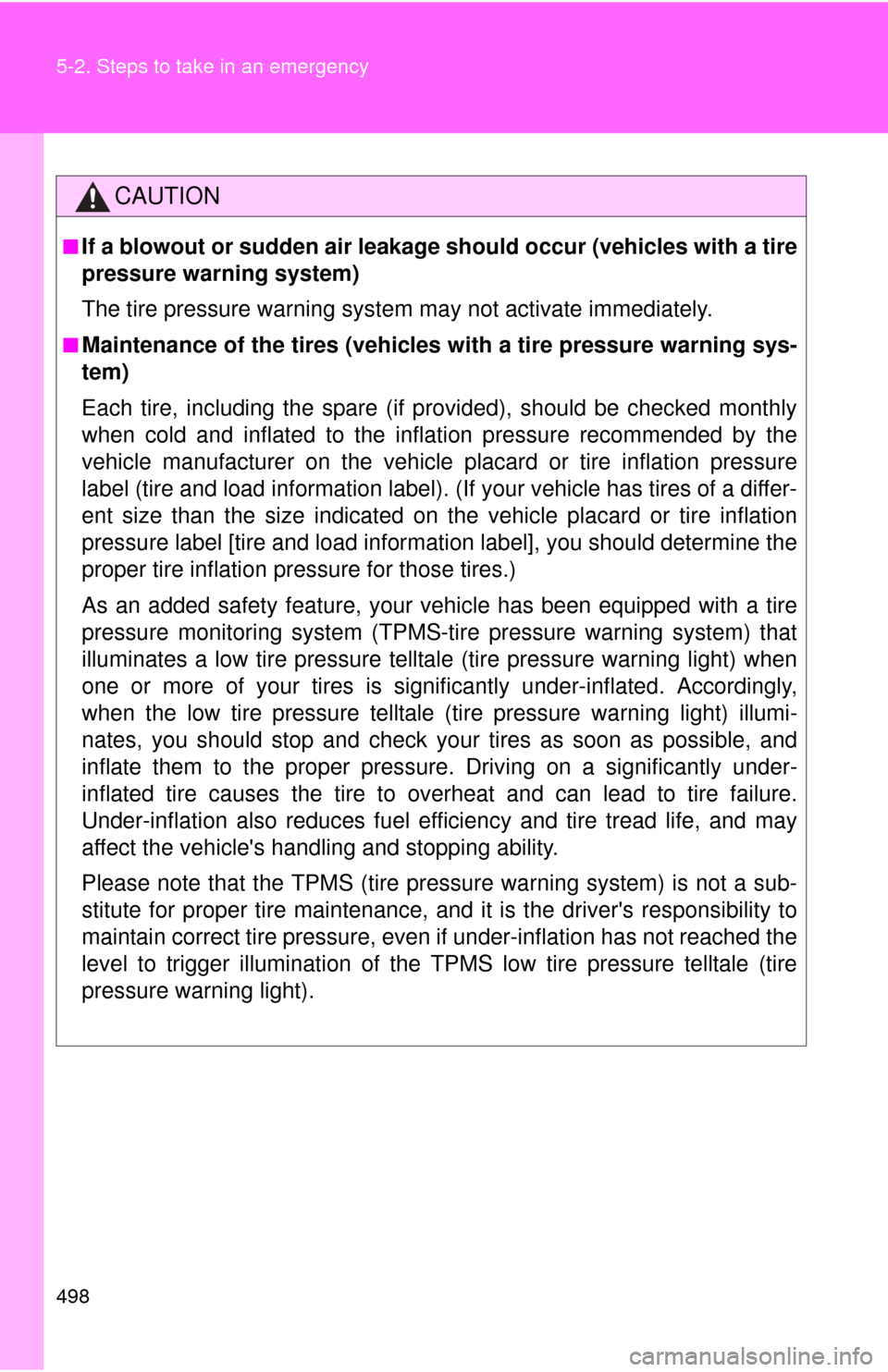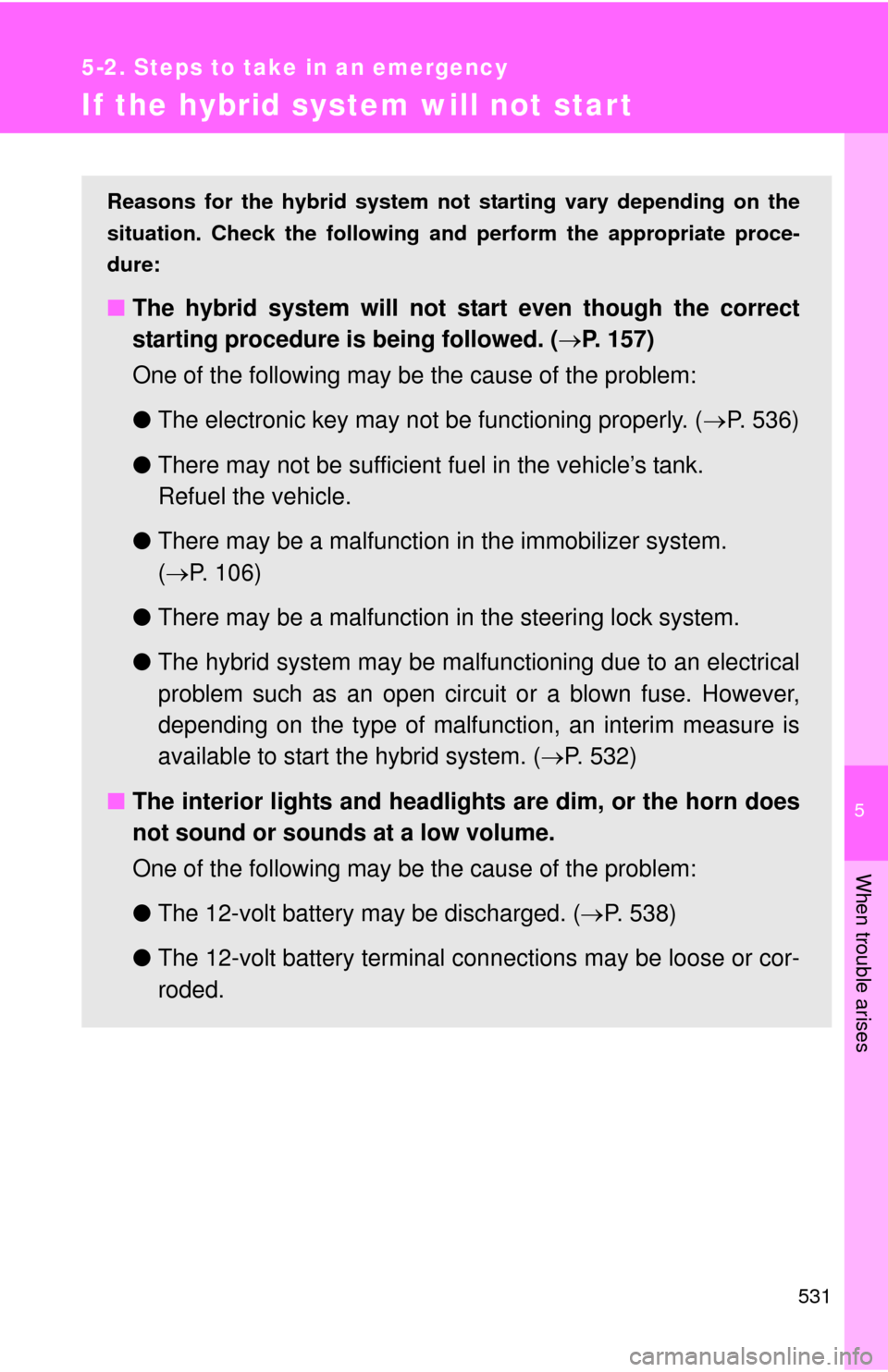Page 451 of 612

451
4-3. Do-it-yourself maintenance
4
Maintenance and care
■Effects of incorrect tire inflation pressure
Driving with incorrect ti
re inflation pressure ma y result in the following:
●Reduced fuel efficiency
●Reduced driving comfort and tire life
●Reduced safety
●Damage to the drive train
If a tire needs frequent inflating, have it checked by your Toyota dealer.
■Instructions for checking tire inflation pressure
When checking tire inflation pressure, observe the following:
●Check only when the tires are cold.
If your vehicle has been parked for at least 3 hours or has not been
driven for more than 1 mile or 1.5 km, you will get an accurate cold
tire inflation pressure reading.
●Always use a tire pressure gauge.
The appearance of the tire can be mi sleading. In addition, tire infla-
tion pressure that is even just a few pounds off can affect ride quality
and handling.
●Do not reduce tire inflation pressure after driving. It is normal for tire
inflation pressure to be higher after driving.
●Never exceed the vehicle capacity weight.
Passengers and luggage weight should be placed so that the vehicle
is balanced.
Page 463 of 612
463
4-3. Do-it-yourself maintenance
4
Maintenance and care
Fuse block on the back of the cover
FuseAmpereCircuit
1 METER-IG2 5 A Gauge and meters
2 FAN 50 A Electric cooling fans
3 H-LP CLN 30 A No circuit
4 ENG W/PMP 30 A Multiport fuel injection system/
sequential multiport fuel injection
system
5 PTC HTR NO.2 50 A PTC heater
6 PTC HTR NO.1 50 A PTC heater
7 HTR 50 A Air conditioning system
8 DC/DC 120 A Hybrid system
9 ABS NO.1 30 A Electronically controlled brake sys-
tem
10 H-LP-MAIN 30 A H-LP LH-LO, H-LP RH-LO, MNL H-
LP LVL, headlight (low beam)
11 ABS MTR NO.2 50 A Electronically controlled brake sys-
tem
12 ABS MTR NO.1 50 A Electronically controlled brake sys-
tem
Page 464 of 612

464 4-3. Do-it-yourself maintenance
13 R/B NO.250 A IGCT-MAIN, INV W/PMP
14 EPS 80 A Electric power steering
15 S-HORN 7.5 A S-HORN
16 DEICER 15 A No circuit
17 HORN 10 A Horns
18 EFI NO.2 15 AMultiport fuel injection system/
sequential multiport fuel injection
system
19 EFI NO.3 7.5 AMultiport fuel injection system/
sequential multiport fuel injection
system
20 INJ 7.5 AMultiport fuel injection system/
sequential multiport fuel injection
system
21 ECU-IG2 NO.3 7.5 A Multiport fuel injection system/
sequential multiport fuel injection
system, steering lock system,
hybrid system
22 IGN 15 A Starter system
23 D/L-AM2 20 A No circuit
24 IG2-MAIN 25 AIGN, INJ, METER-IG2, ECU-IG2
NO.3, A/B, ECU-IG2 NO.2, ECU-
IG2 NO.1
25 DC/DC-S 7.5 A Hybrid system
26 MAYDAY 5 A MAYDAY
27 TURN&HAZ 15 A Turn signal lights, emergency
flashers, gauge and meters
28 STRG LOCK 10 A Steering lock system
29 AMP 15 A Audio system
30 H-LP LH-LO 15 A
*1
Left-hand headlight (low beam)
20 A*2
FuseAmpereCircuit
Page 465 of 612

465
4-3. Do-it-yourself maintenance
4
Maintenance and care
*1: Vehicles with halogen headlight
*2: Vehicles with discharge headlight
31 H-LP RH-LO
15 A
*1
Right-hand headlight (low beam)
20 A*2
32 MNL H-LP
LV L*27.5 A Manual headlight leveling system
33 EFI-MAIN NO.1 30 A Multiport fuel injection system/
sequential multiport fuel injection
system, EFI NO.2, EFI NO.3
34 SMART 5 A Smart key system
35 ETCS 10 A Electronic throttle control system
36 ABS NO.2 7.5 A Electronically controlled brake sys-
tem
37 EFI NO.1 7.5 A Multiport fuel injection system/
sequential multiport fuel injection
system
38 EFI-MAIN NO.2 20 A A/F sensor
39 AM2 7.5 A Hybrid system
40 RADIO-B 20 A Audio system, navigation system
41 DOME 7.5 A Clock, vanity lights, interior lights,
personal lights, trunk light, door
courtesy lights
42 ECU-B NO.1 10 A Smart key system, gauge and
meters, Blind Spot Monitor, steer-
ing sensor, occupant classification
system, multiplex communication
system
43 SPARE 25 A Spare fuse
44 SPARE 30 A Spare fuse
FuseAmpereCircuit
Page 493 of 612
5
When trouble arises
493
5-2. Steps to take in an emergency
Follow the correction procedures.
After taking the specified steps to correct the suspected problem,
check that the warning light goes off.
Warning lightWarning light/DetailsCorrection procedure
Open door warning light
(warning buzzer)
*1
Indicates that a door or the
trunk is not fully closed. Check that all doors and the
trunk are closed.
Low fuel level warning
light Indicates remaining fuel is
approximately 2.6 gal. (9.7
L, 2.1 Imp. gal.) or less. Refuel the vehicle.
Driver’s/front passen-
ger’s seat belt reminder
light (warning buzzer)
*2
Warns the driver/front pas-
senger to fasten his/her
seat belt. Fasten the seat belt.
Master warning light A buzzer sounds and the
warning light comes on
and flashes to indicate that
the master warning system
has detected a malfunc-
tion. P. 500
Page 495 of 612

5
When trouble arises
495
5-2. Steps to take in an emergency
■
SRS warning light
This warning light system monitors the airbag sensor assembly, front airbag
sensors, side and curtain shield airbag sensors, curtain shield airbag sen-
sors, driver's seat belt buckle switch, front passenger occupant classification
system (ECU and sensors), “AIR BAG ON” indicator light, “AIR BAG OFF”
indicator light, front passenger's seat belt buckle switch, seat belt preten-
sioner assemblies, airbags, interc onnecting wiring and power sources.
( P. 113)
■ Front passenger detection sensor, passenger seat belt reminder and
warning buzzer
● If luggage is placed on the front passenger seat, the front passenger
detection sensor may cause the warning light to flash and the warning
buzzer to sound even if a passenger is not sitting in the seat.
● If a cushion is placed on the seat, the sensor may not detect a passen-
ger, and the warning light may not operate properly.
■ If the malfunction indicator lamp comes on while driving
First check the following:
● Is the fuel tank empty?
If it is, fill the fuel tank immediately.
● Is the fuel tank cap loose?
If it is, tighten it securely.
The malfunction indicator lamp will go off after several driving trips.
If the malfunction indicator lamp does not go off even after several trips, con-
tact your Toyota dealer as soon as possible.
■
The tire pressure warning light may come on due to natural causes
(vehicles with a tire pressure warning system)
The tire pressure warning light may come on due to natural causes such
as natural air leaks and tire inflat ion pressure changes caused by tem-
perature. In this case, adjusting the tire inflation pressure will turn off the
warning light (after a few minutes).
Page 498 of 612

498 5-2. Steps to take in an emergency
CAUTION
■If a blowout or sudden air leakage should occur (vehicles with a tire
pressure warning system)
The tire pressure warning syste m may not activate immediately.
■Maintenance of the tires (vehicles with a tire pressure warning sys-
tem)
Each tire, including the spare (if provided), should be checked monthly
when cold and inflated to the inflation pressure recommended by the
vehicle manufacturer on the vehicle placard or tire inflation pressure
label (tire and load information label). (If your vehicle has tires of a differ-
ent size than the size indicated on the vehicle placard or tire inflation
pressure label [tire and load information label], you should determine the
proper tire inflation pr essure for those tires.)
As an added safety feature, your vehicle has been equipped with a tire
pressure monitoring system (TPMS-ti re pressure warning system) that
illuminates a low tire pressure telltal e (tire pressure warning light) when
one or more of your tires is significantly under-inflated. Accordingly,
when the low tire pressu re telltale (tire pressure warning light) illumi-
nates, you should stop and check your tires as soon as possible, and
inflate them to the proper pressure. Driving on a significantly under-
inflated tire causes the tire to overheat and can lead to tire failure.
Under-inflation also reduces fuel effi ciency and tire tread life, and may
affect the vehicle's hand ling and stopping ability.
Please note that the TPMS (tire pressure warning system) is not a sub-
stitute for proper ti re maintenance, an d it is the driver's responsibility to
maintain correct tire pressure, even if under-inflation has not reached the
level to trigger illu mination of the TPMS low tire pressure telltale (tire
pressure warning light).
Page 531 of 612

5
When trouble arises
531
5-2. Steps to take in an emergency
If the hybrid system will not start
Reasons for the hybrid system not starting vary depending on the
situation. Check the following and perform the appropriate proce-
dure:
■ The hybrid system will not start even though the correct
starting procedure is being followed. ( P. 157)
One of the following may be the cause of the problem:
● The electronic key may not be functioning properly. ( P. 536)
● There may not be sufficient fuel in the vehicle’s tank.
Refuel the vehicle.
● There may be a malfunction in the immobilizer system.
( P. 106)
● There may be a malfunction in the steering lock system.
● The hybrid system may be malfun ctioning due to an electrical
problem such as an open circuit or a blown fuse. However,
depending on the type of malf unction, an interim measure is
available to start the hybrid system. ( P. 532)
■ The interior lights and headlights are dim, or the horn does
not sound or sounds at a low volume.
One of the following may be the cause of the problem:
●The 12-volt battery may be discharged. ( P. 538)
● The 12-volt battery terminal c onnections may be loose or cor-
roded.